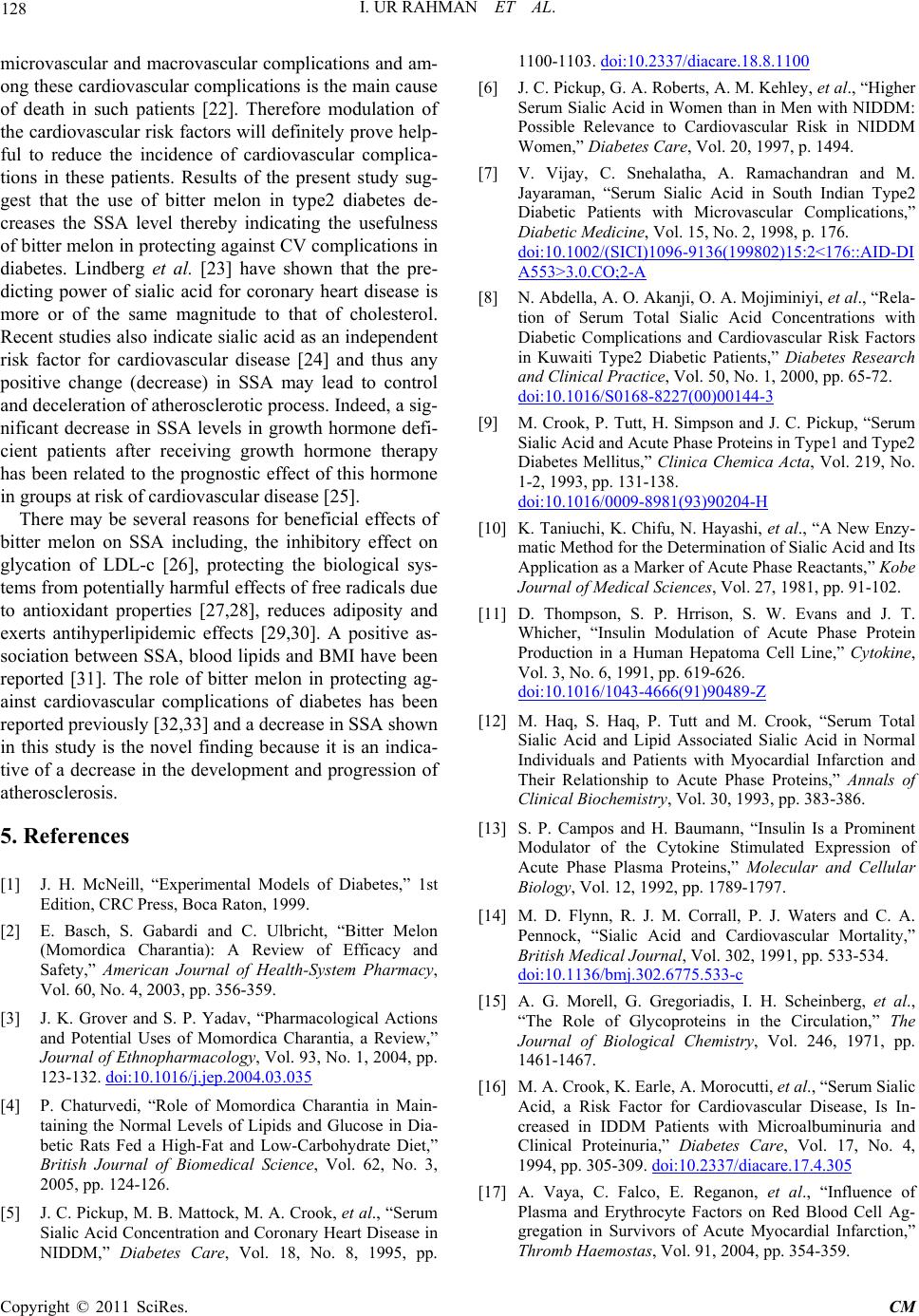
I. UR RAHMAN ET AL.
128
microvascular and macrovascular complications and am-
ong these cardiovascular complications is the main cause
of death in such patients [22]. Therefore modulation of
the cardiovascular risk factors will definitely prove help-
ful to reduce the incidence of cardiovascular complica-
tions in these patients. Results of the present study sug-
gest that the use of bitter melon in type2 diabetes de-
creases the SSA level thereby indicating the usefulness
of bitter melon in protecting against CV complications in
diabetes. Lindberg et al. [23] have shown that the pre-
dicting power of sialic acid for coronary heart disease is
more or of the same magnitude to that of cholesterol.
Recent studies also indicate sialic acid as an independent
risk factor for cardiovascular disease [24] and thus any
positive change (decrease) in SSA may lead to control
and deceleration of atherosclerotic process. Indeed, a sig-
nificant decrease in SSA levels in growth hormone defi-
cient patients after receiving growth hormone therapy
has been related to the prognostic effect of this hormone
in groups at risk of cardiovascular disease [25].
There may be several reasons for beneficial effects of
bitter melon on SSA including, the inhibitory effect on
glycation of LDL-c [26], protecting the biological sys-
tems from potentially harmful effects of free radicals due
to antioxidant properties [27,28], reduces adiposity and
exerts antihyperlipidemic effects [29,30]. A positive as-
sociation between SSA, blood lipids and BMI have been
reported [31]. The role of bitter melon in protecting ag-
ainst cardiovascular complications of diabetes has been
reported previously [32,33] and a decrease in SSA shown
in this study is the novel finding because it is an indica-
tive of a decrease in the development and progression of
atherosclerosis.
5. References
[1] J. H. McNeill, “Experimental Models of Diabetes,” 1st
Edition, CRC Press, Boca Raton, 1999.
[2] E. Basch, S. Gabardi and C. Ulbricht, “Bitter Melon
(Momordica Charantia): A Review of Efficacy and
Safety,” American Journal of Health-System Pharmacy,
Vol. 60, No. 4, 2003, pp. 356-359.
[3] J. K. Grover and S. P. Yadav, “Pharmacological Actions
and Potential Uses of Momordica Charantia, a Review,”
Journal of Ethnopharmacology, Vol. 93, No. 1, 2004, pp.
123-132. doi:10.1016/j.jep.2004.03.035
[4] P. Chaturvedi, “Role of Momordica Charantia in Main-
taining the Normal Levels of Lipids and Glucose in Dia-
betic Rats Fed a High-Fat and Low-Carbohydrate Diet,”
British Journal of Biomedical Science, Vol. 62, No. 3,
2005, pp. 124-126.
[5] J. C. Pickup, M. B. Mattock, M. A. Crook, et al., “Serum
Sialic Acid Concentration and Coronary Heart Disease in
NIDDM,” Diabetes Care, Vol. 18, No. 8, 1995, pp.
1100-1103. doi:10.2337/diacare.18.8.1100
[6] J. C. Pickup, G. A. Roberts, A. M. Kehley, et al., “Higher
Serum Sialic Acid in Women than in Men with NIDDM:
Possible Relevance to Cardiovascular Risk in NIDDM
Women,” Diabetes Care, Vol. 20, 1997, p. 1494.
[7] V. Vijay, C. Snehalatha, A. Ramachandran and M.
Jayaraman, “Serum Sialic Acid in South Indian Type2
Diabetic Patients with Microvascular Complications,”
Diabetic Medicine, Vol. 15, No. 2, 1998, p. 176.
doi:10.1002/(SICI)1096-9136(199802)15:2<176::AID-DI
A553>3.0.CO;2-A
[8] N. Abdella, A. O. Akanji, O. A. Mojiminiyi, et al., “Rela-
tion of Serum Total Sialic Acid Concentrations with
Diabetic Complications and Cardiovascular Risk Factors
in Kuwaiti Type2 Diabetic Patients,” Diabetes Research
and Clinical Practice, Vol. 50, No. 1, 2000, pp. 65-72.
doi:10.1016/S0168-8227(00)00144-3
[9] M. Crook, P. Tutt, H. Simpson and J. C. Pickup, “Serum
Sialic Acid and Acute Phase Proteins in Type1 and Type2
Diabetes Mellitus,” Clinica Chemica Acta, Vol. 219, No.
1-2, 1993, pp. 131-138.
doi:10.1016/0009-8981(93)90204-H
[10] K. Taniuchi, K. Chifu, N. Hayashi, et al., “A New Enzy-
matic Method for the Determination of Sialic Acid and Its
Application as a Marker of Acute Phase Reactants,” Kobe
Journal of Medical Sciences, Vol. 27, 1981, pp. 91-102.
[11] D. Thompson, S. P. Hrrison, S. W. Evans and J. T.
Whicher, “Insulin Modulation of Acute Phase Protein
Production in a Human Hepatoma Cell Line,” Cytokine,
Vol. 3, No. 6, 1991, pp. 619-626.
doi:10.1016/1043-4666(91)90489-Z
[12] M. Haq, S. Haq, P. Tutt and M. Crook, “Serum Total
Sialic Acid and Lipid Associated Sialic Acid in Normal
Individuals and Patients with Myocardial Infarction and
Their Relationship to Acute Phase Proteins,” Annals of
Clinical Bioche mi str y, Vol. 30, 1993, pp. 383-386.
[13] S. P. Campos and H. Baumann, “Insulin Is a Prominent
Modulator of the Cytokine Stimulated Expression of
Acute Phase Plasma Proteins,” Molecular and Cellular
Biology, Vol. 12, 1992, pp. 1789-1797.
[14] M. D. Flynn, R. J. M. Corrall, P. J. Waters and C. A.
Pennock, “Sialic Acid and Cardiovascular Mortality,”
British Medical Journal, Vol. 302, 1991, pp. 533-534.
doi:10.1136/bmj.302.6775.533-c
[15] A. G. Morell, G. Gregoriadis, I. H. Scheinberg, et al.,
“The Role of Glycoproteins in the Circulation,” The
Journal of Biological Chemistry, Vol. 246, 1971, pp.
1461-1467.
[16] M. A. Crook, K. Earle, A. Morocutti, et al., “Serum Sialic
Acid, a Risk Factor for Cardiovascular Disease, Is In-
creased in IDDM Patients with Microalbuminuria and
Clinical Proteinuria,” Diabetes Care, Vol. 17, No. 4,
1994, pp. 305-309. doi:10.2337/diacare.17.4.305
[17] A. Vaya, C. Falco, E. Reganon, et al., “Influence of
Plasma and Erythrocyte Factors on Red Blood Cell Ag-
gregation in Survivors of Acute Myocardial Infarction,”
Thromb Haemostas, Vol. 91, 2004, pp. 354-359.
Copyright © 2011 SciRes. CM